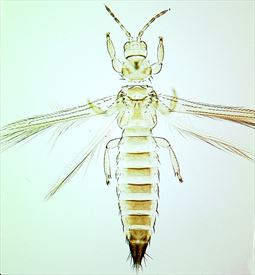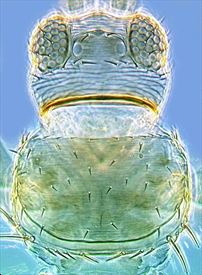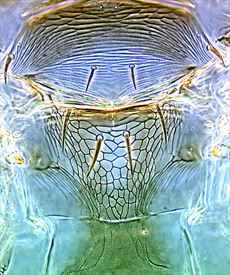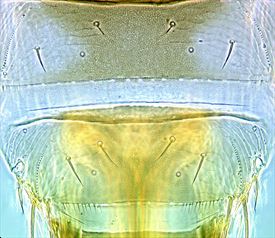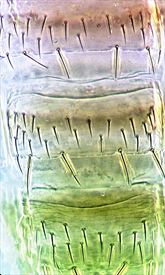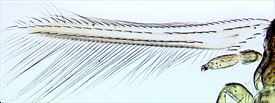Distinguishing features
Both sexes fully winged. Female yellow to brown, typically yellow with brown postoccipital ridge on head, brown markings medially on each tergite, and tergites VIII–X brown; fore wings pale but shaded along veins, major setae often dark. Antennae 7-segmented, VI large and bullet-shaped. Head with ocellar setae III arising inside ocellar triangle. Pronotal posteromarginal transverse apodeme usually stout, postero-angular setae short. Metanotum reticulate, reticles without internal markings, median setae arise behind anterior margin, campaniform sensilla present. Fore wing with first vein setal row almost uninterrupted; clavus with 6 marginal setae. Abdominal tergite II with 4 lateral setae, VIII with marginal comb not developed medially. Sternites with 15–40 discal setae, 3 pairs of marginal setae; pleurotergites with 6–10 discal setae.
Male similar to female in structure, but smaller and paler; tergite VIII with no comb; tergite IX with 4 setae close set in a transverse row; sternites III–VII with small transverse pore plate anterior to about 10 discal setae.
Related species
There are 13 species of the genus Thrips recorded from New Zealand, of which five comprise an endemic group, out of a total of 280 species worldwide (Mound & Masumoto, 2005). All members of Thrips genus have paired ctenidia on the tergites, and on tergite VIII these are postero-mesad to the spiracles, and these species also lack ocellar setae pair I in front of the first ocellus. In contrast, Frankliniella species have ctenidia on tergite VIII antero-lateral to the spiracles, and a pair of setae is always present in front of the first ocellus. Thrips australis is an Australian species, and has the unusual characteristic of bearing 6, instead of 5, veinal setae on the fore wing clavus. However, a clavus with 6 veinal setae also occurs in some species from Africa, and the larvae are essentially similar to those of other members of the genus Thrips (Vierbergen et al., 2010).
Biological data
Breeding in the flowers of Eucalyptus species, particularly in white flowers, but also of Melaleuca species [Myrtaceae] with white flowers. However, when flowers on Eucalyptus trees die, adults of australis disperse in large numbers onto surrounding plants, and can then be found in the flowers of a very wide range of unrelated plants.
Distribution data
Widespread in New Zealand (ND, AK, BP, TO, HB / NN, MB, SI) where it has been found throughout the year. It occurs thoughout Australia, and is found worldwide in association with Eucalyptus plantings.
Family name
THRIPIDAE, THRIPINAE
Species name
Thrips australis (Bagnall)
Original name and synonyms
Isoneurothrips australis Bagnall, 1915: 592
Thrips lacteicorpus Girault, 1926: 17
Thrips mediolineus Girault, 1926a: 18
Anomalothrips amygdali Morgan, 1929: 5
References
Mound LA & Masumoto M (2005) The genus Thrips (Thysanoptera, Thripidae) in Australia, New Caledonia and New Zealand. Zootaxa 1020: 1–64.
Mound LA, Tree DC & Paris D (2012) OzThrips – Thysanoptera in Australia. http://www.ozthrips.org/

